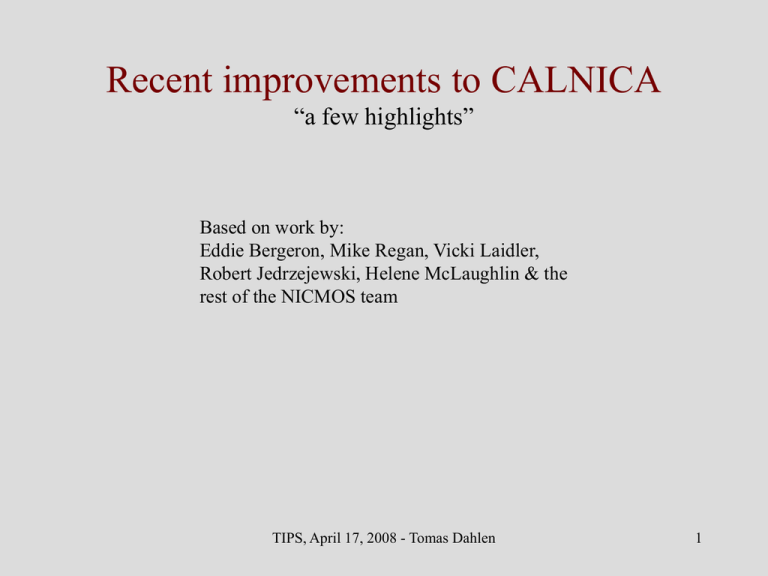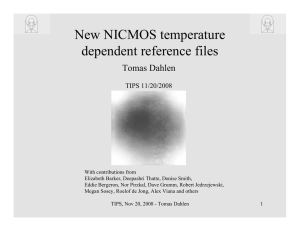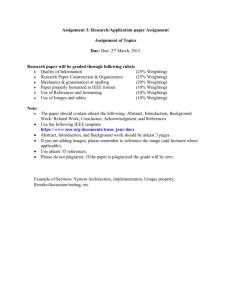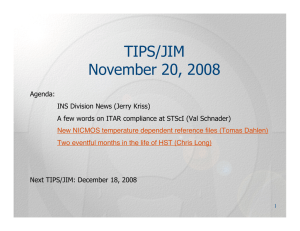Recent improvements to CALNICA “a few highlights”
advertisement

Recent improvements to CALNICA “a few highlights” Based on work by: Eddie Bergeron, Mike Regan, Vicki Laidler, Robert Jedrzejewski, Helene McLaughlin & the rest of the NICMOS team TIPS, April 17, 2008 - Tomas Dahlen 1 CALNICA overview CALNICA performs instrumental calibration of NICMOS data: - zero-read subtraction - dark current subtraction - correction for non-linearity - flat-fielding - cosmic ray identification and rejection - calculation of count rates - population of photometric keywords CALNICA is used by pipeline/OTFR to produce final calibrated images CALNICA is available in STSDAS so that users can customize calibration Major improvements • Optimum weighting when calculating count rates from up-the-ramp sampling. • New way of handling cosmic rays. Additional updates includes • Detecting and flagging curvature in detector response • Spike rejection • Saturation in zeroth read •… TIPS, April 17, 2008 - Tomas Dahlen 2 Highlight #1: optimal weighting CALNICA uses up-the-ramp sampling with non-destructive read-outs during the exposure. The count-rate is given by the slope of a straight line fitted to the data using a least square fit. High count rate case Low count rate case Which is the best way to weight the reads in the up-the-ramp sampling? TIPS, April 17, 2008 - Tomas Dahlen 3 Highlight #1: optimal weighting Fixen et al. (2000) show that for pure read noise, equal weighting of each sample gives best result, while for pure Poisson noise, only using the first and last read is the best. For any normal situation, the case will lie in between these. Optimum weighting from Fixen et al. 2000. Weighting applied by CALNICA in previous version. The variance in the flux estimate decreases by up to 15% “Meaningful” errors - representing read noise TIPS, April 17, 2008 - Tomas Dahlen 4 Highlight #2: proper CR rejection Previous CALNICA version subtracted the CR-jump from post CR affected reads Introduces √2 x read noise bias in all post CR reads Black dots: counts as read by Calnica. Red curve: old way of calculating the slope CR jump between “stars”. Black curves: new CALNICA calculates separate slopes that are weighted together. A maximum of three separate slopes are used. Red dots: counts corrected for CR jump in old Calnica Preliminary results: Median increase in S/N for a set 57 different flat-fields is ~ 9%. TIPS, April 17, 2008 - Tomas Dahlen 5 Highlight #3: “curvature” detection In some special cases, NICMOS shows a variable response that can have either positive or negative curvature. Occurs at “sharp” sources (points sources, CRs). Appears to be due to insufficient settling time in A/D conversion while clocking. Old CALNICA did not detect these. New CALNICA detects positive curvature via CR detection (initially led to crash). If there are >2 CRs in one read, then CALNICA interprets this as curvature and not CRs. New DQ flag is set DQ=16384 (curvature in detector response). The slope is calculated ignoring the curvature. Combined effect of positive and negative curvature seems to average out. TIPS, April 17, 2008 - Tomas Dahlen 6 Summary Two main features in the improved CALNICA: • Optimum weighting when calculating count rates from up-the-ramp sampling. • New way of handling cosmic rays. A number of minor additional updates (will be presented in an ISR). Final testing is ongoing. To be included in OPUS 2008.2 and in next STSDAS release (~after Summer). TIPS, April 17, 2008 - Tomas Dahlen 7






